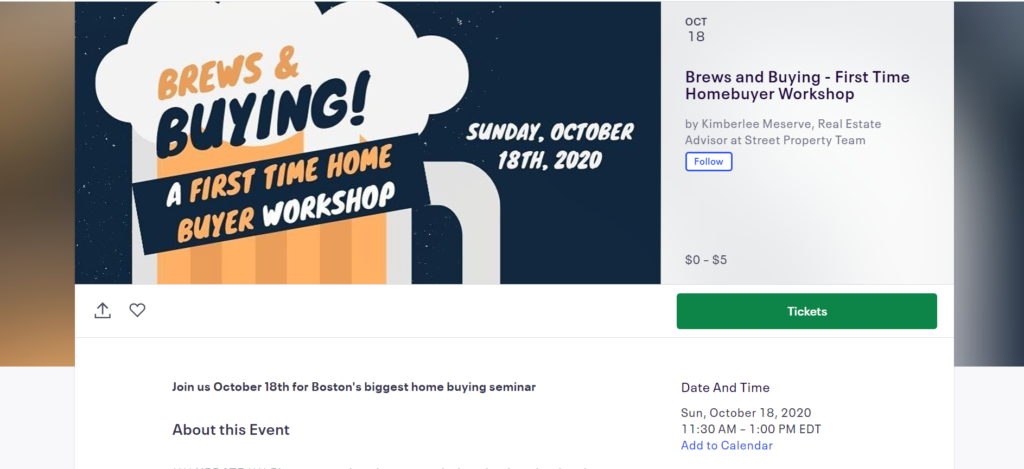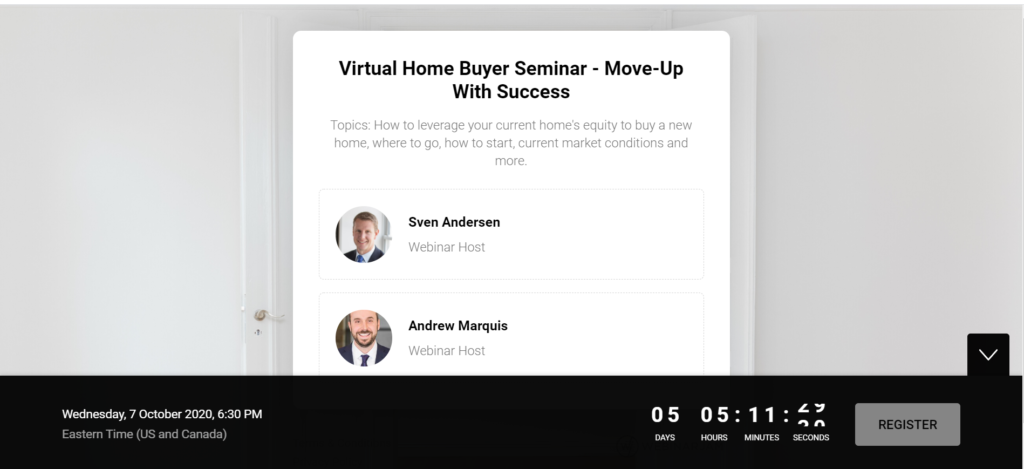For many real estate agents, client events are a beloved way to create community, engage their sphere of influence, and, most importantly, bring in a robust roster of new potential clients. As social distancing and lockdown orders became the norm earlier this year, agents pivoted from in-person to virtual events on a dime. Even without an in-person component, many have gotten creative with their virtual lead generation strategies and produced powerful events that keep potential clients informed and engaged.
Below, two top-producing Massachusetts-based agents share their blueprints for creating highly successful virtual seminars (and the in-person strategies they will be resuming once the time is right).
Virtual Homeownership Seminars: Kimberlee Meserve
While she has been a real estate agent for five years, Kimberlee Meserve spent the last two years in a market that was brand new to her: Boston. When she relocated to the area, she began creating her sphere of influence from scratch. “I decided I was going to take an educational-based approach to building my business and make sure that no one had the same experiences of not understanding the process that I had when buying my first home,” she says. With that in mind, Meserve began hosting first-time homebuyer seminars – now a cornerstone of her business.
Related reading: A Step-by-Step Guide to Hosting a Virtual Homeownership Seminar
The Prep and Advertising
Meserve creates buzz around her virtual seminar through simple Facebook ads. Keller Williams agents can further simplify the process by running ads directly through Campaigns. “The copy is simple. It will read something like ‘Are you looking to buy a home? Come find out about the special financing available to first-time homebuyers,” she said. It will also contain a link to the event registration page.
To determine ad spending, she says, “A rule of thumb is looking at the first few numbers of the potential reach of your area. For example, if you have a reach of 20,000 people, you would spend $200 for the life of the ad. If you have a reach of 40,000 people, you will spend $400.”
Meserve uses the Eventbrite platform as a registration portal. On the Eventbrite page, interested parties can find all the event information, as well as testimonials and an option to make a small donation to a local animal rescue league. Once they register, Eventbrite captures contact information including name, email address, and phone number. A day before the event, Meserve texts registrants in order to confirm their attendance.
“I like to create scarcity, so I will say ‘We only have limited seating. Please respond yes if you will be attending.’ In addition, she will send out the link for the seminar as well as the learning materials that are used during the presentation.
On the back end, she uses the online tool Zapier to send any new Eventbrite leads straight into Command. That way, anyone who is about to attend an event gets funneled into a SmartPlan to receive a steady drip of communication from Meserve. The first touch within that SmartPlan is a text message with a link to a video on her YouTube channel, thanking registrants for joining.

Meserve’s In-Person Seminar
Meserve employed the same advertising strategy whether she was promoting her in-person event or her virtual one. Before the shift, she hosted first-time homebuyer seminars in the private events area of a local brewery in partnership with her lender. They split the cost of the event, with her paying for costs associated with her Facebook ad lead gen efforts, and the lender paying for the cost of the brewery.
Instead of a PowerPoint presentation, Meserve created a branded workbook containing fill-in-the-blank exercises, areas for note-taking, and her contact information. At the event, each attendee received a copy of the workbook, and she and her lender took turns addressing different sections of the workbook. After the seminar, attendees had the option of signing up for appointments through a sign-up sheet.
According to Meserve, there was one major call to action she hoped to get across: “I’m setting the expectation with people that even if they are 12 to 18 months out, they should absolutely start working through the process, even if that means just having a conversation with my lender.”
The Pivot to Virtual
The decision to continue hosting her first-time homebuyer seminar was a no-brainer for Meserve. “My whole goal for the year is planned around how many events I will have,” she says. “I usually have 20 to 30 people attending per event, and a 20 percent conversion rate.” Although, she shares, in the virtual world, she sees lower attendance rates but a higher conversion rate.
Meserve’s pivot to virtual was a natural transition. Instead of hosting at the brewery, she used the Zoom platform to connect with her sphere. The pre-seminar prep, advertising strategy, and educational materials remained the same – only in the new process, the workbook is sent to attendees via PDF. “The only difference is that we really have to be purposeful about encouraging engagement and getting people to turn their cameras on, type in the chat box, and unmute themselves,” she says.
When following up, Meserve checks in to ask attendees their thoughts on the event, whether they have other questions, and if they want to be set on an appointment for a preliminary search.
Buyers’ and Sellers’ Seminars: Sven Andersen
Winchester, Massachusetts-based Andersen Group Realty CEO Sven Anderson hosts buyer and seller seminars that boast a thirty percent conversion rate. Sven hosts four different seminars geared toward different audiences: buyers, downsizers, move-ups, and investors. By moving to a virtual environment, he was able to automate parts of the event process while maintaining the quality of information offered. Here is how he shifted.
The Prep and Advertising
Andersen’s audience varies slightly from Meserve’s. Therefore, a significant portion of his advertising efforts are focused on newspapers and direct mail – areas where his audience are putting in the time. His local newspaper ads contain simple home photography and copy (“Register for our virtual seminar”), and a QR code which allows people to pull out their smartphone, snap a photo, and be taken directly to the registration page. For direct mailers, they will send out a property card containing the same QR code as the newspaper ad. In both instances, Andersen makes note of the four different seminar tracks offered. The information is also shared through the team’s Facebook, Instagram, and website.

Andersen’s In-Person Seminars
Before the shift, Andersen’s team would host seminars at a nearby restaurant, with special guests including a mortgage professional, an attorney, a lender, and an accountant. In particular, the team zeroed in on downsizing seminars, as they yielded the highest return on investment. Each event generally brought on 30 to 40 people in a market that was popular for downsizing from larger homes to condos.
The Pivot to Virtual
After identifying the four tracks he wanted to move forward with, Andersen hosted one live virtual seminar through Zoom for each individual track. For the events, Andersen used a tool called WebinarJam, which enables you to shoot webinars and play them over and over, allowing him to provide the experience of a live event for each client without personally being present each time.
The event is marketed as if it will be live, and guests are required to register through WebinarJam before the start of the event. To register, guests provide their phone number, email, and geographical region. After submitting their information, guests receive a video thanking them for registering and inquiring about the questions they want answered during the event. Between the four tracks, Andersen’s team receives 200 to 400 registrations per month.
Each week, Andersen runs two of his seminars, which are recorded, while a member of the team is on-call in the chat box to answer any questions being generated. If someone asks a question better suited for an accountant or attorney, the team will follow up. Although WebinarJam plays the recording, the event was recorded in a way that is not dated. On video, Andersen engages with the audience, asks for questions, and allows the appropriate pauses for note taking.
Post-event, a team member will reach out to the attendees for a service call asking how they can help and if they were able to get everything they wanted out of the webinar.
Download Our Customizable Homeownership Seminar